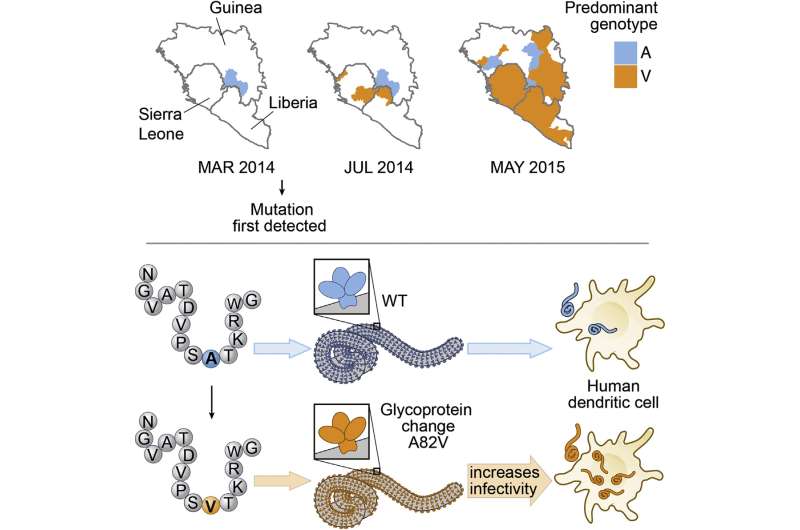Ebola adapted to better infect humans during 2013-2016 epidemic

Researchers have identified mutations in Ebola virus that emerged during the 2013-2016 Ebola virus epidemic in West Africa that increased the ability of the virus to infect human cells, two independent teams of researchers are reporting November 3 in Cell.
"Ebola virus is thought to circulate in an unknown animal reservoir and to only rarely cross over into people. When the virus does cross over, the effect has been devastating to those people who are infected. Until recently, the human disease outbreaks have been short lived, and the virus has had little opportunity to adapt genetically to the human host," says Jeremy Luban, a co-author of one of the papers and Professor at the University of Massachusetts Medical School.
By the end of the Ebola virus disease epidemic in 2016, more than 28,000 people had been infected with the virus, and more than 11,000 people died from Ebola virus disease. To investigate whether the virus might have changed genetically in response to infection of such large numbers of people, the research teams used publicly available Ebola virus genomic sequences to track virus mutations. The teams found that mutations of the gene that encodes the Ebola virus glycoprotein increased the virus' ability to infect cells of humans and other primates. By increasing infectivity in human cells, it is possible that these mutations increased Ebola virus spread during the outbreak.

"If you introduce a virus into a new host, like humans, it may need to adapt to better infect and spread in that host," says Jonathan Ball, a virologist at the University of Nottingham and co-author of the other paper. One particular mutation, studied by both groups, emerged early in the outbreak just as case numbers vastly increased and soon became the dominant virus type circulating in the outbreak.
The Ebola virus mutations did not increase the ability of Ebola virus to infect cells from other mammalian species, including fruit bats, the presumed natural host of Ebola virus. "We found that, as Ebola virus was spreading from human to human, it apparently didn't have to worry about maintaining its infectivity in bats," Ball says.
The research teams are continuing their work to learn more about how these specific mutations made the Ebola virus more infectious for human cells. "It's important to understand how these viruses evolve during outbreaks," says Luban. "By doing so, we will be better prepared should these viruses spill over to humans in the future."
More information: Cell, Diehl, William, Kyusik, Kim, McCauley, Sean, Donnard, Elisa, Kucukural, Alper, McDonel, Patrick, Garber, Manuel, Luban, Jeremy, et al.: "Ebola virus glycoprotein with increased infectivity dominated the 2013-2016 epidemic" www.cell.com/cell/fulltext/S0092-8674(16)31397-6 . DOI: 10.1016/j.cell.2016.10.014
Cell, Urbanowicz, Richard, McClure, Patrick, Ball, Jonathan, et al: "Human adaptation of Ebola virus during the West African outbreak." www.cell.com/cell/fulltext/S0092-8674(16)31396-4 , DOI: 10.1016/j.cell.2016.10.013
Journal information: Cell
Provided by Cell Press


















